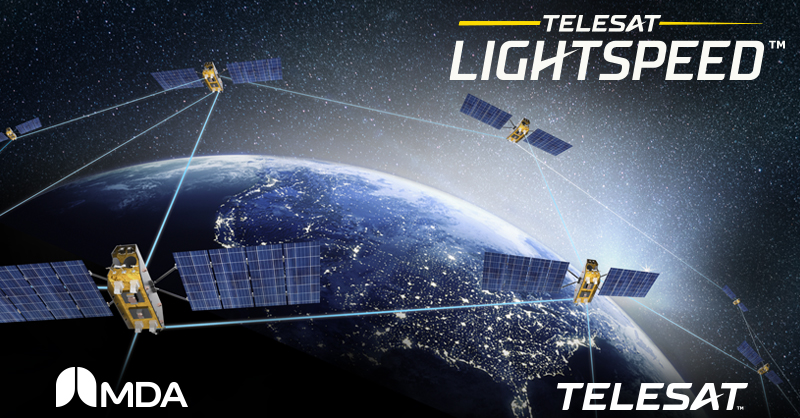
MDA Ltd. will build 198 advanced satellites for the Telesat Lightspeed Low Earth Orbit program.
It is all systems go for Canadian operator Telesat and its Lightspeed LEO satellite constellation. In a surprise announcement on Friday, the company confirmed that the long-awaited constellation is now fully funded and that it has contracted MDA to build the 198 satellites needed for the system. Lightspeed satellite launches are now scheduled to commence in mid-2026 and polar and global services scheduled to begin in late 2027.
Gaining funding for such an ambitious program has been a challenge for the operator. Thales Alenia Space was originally contracted to build the satellites, but extended negotiations over financing delayed delivery of proposals to the operator. Original plans for the constellation included nearly 300 satellites, but Telesat decreased the size by 100 satellites after it encountered financing issues.
Telesat now has in place aggregate funding commitments from its Canadian federal and provincial government partners in the combined amount of up to approximately US$2 billion, which it says demonstrates their strong commitment and confidence in the program and the importance of the New Space Economy for Canada. The finalization of this funding is dependent on a number of conditions, including completion of confirmatory due diligence and the conclusion of definitive agreements. This funding, combined with Telesat’s own approximately US$1.6 billion equity contribution, as well as certain vendor financing, would provide the Telesat Lightspeed program with sufficient funds to launch global service, which will occur once the first 156 satellites are in orbit. The capital investment for the Telesat Lightspeed program is approximately US$3.5 billion and includes 198 Telesat Lightspeed satellites, satellite launch vehicles, a global ground network of landing stations and operations centers, business and operations support systems, and expenditures to support the further development of a portfolio of user terminals for Telesat’s target markets.
Telesat is also hopeful that it reap rewards and cost savings through its partnership with MDA, which will redesign the system to take advantage of key technology advances, including MDA’s digital beamforming array antennas and integrated regenerative processor. It believes the redesigned Telesat Lightspeed network will achieve increased network efficiency and enhanced flexibility to focus and dynamically deliver capacity to users. These technology advances allow each satellite to be slightly smaller than the satellites Telesat was previously considering while still maintaining the highest levels of service performance, resiliency, and overall usable capacity in the network. Telesat says these satellites should be highly cost-effective, resulting in an anticipated total capital cost savings for the 198-satellite program of approximately US$2 billion compared to Telesat’s prior capital estimate.
“I’m incredibly proud of the Telesat team for their innovative work to further optimize our Telesat Lightspeed design—which was already a highly advanced and high-performing LEO network—resulting in dramatically reduced costs with unmatched enterprise-class service offerings. MDA is a world-class satellite prime contractor with an impressive track record and a number of recent high-profile, strategic space programs announced, and it is a privilege to be working side-by-side with them on the flagship, game-changing Telesat Lightspeed constellation. MDA’s deep expertise as a LEO prime contractor, as well our own leading expertise in satellite operations and systems engineering, gives us the highest level of confidence in meeting our objectives,” Dan Goldberg, President and CEO of Telesat, said in a statement.
This article was originally published by Via Satellite, a sister publication to Avionics International. It has been edited. Click here to read the original version >>